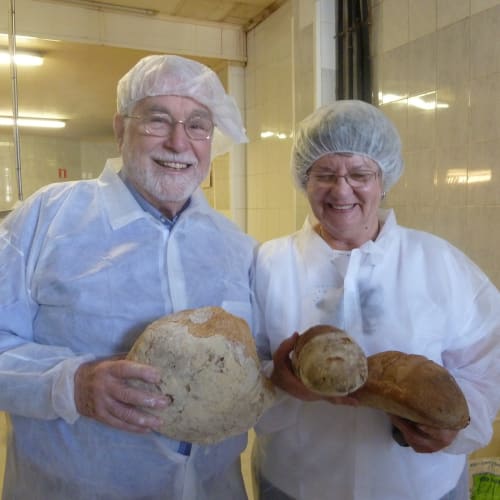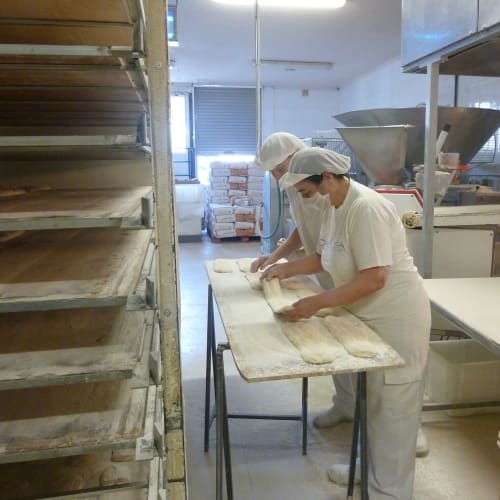Quest for Great Bread
Don Harris | February 2013




There is nothing quite as appealing as the aroma of fresh bread right out of the oven. I remember years ago, when we were living in Andalucía, I would get up first thing in the morning on Saturdays and go to the panadería by the market. The bakery was named Buen Pastora, The Good Shepherd. I would pick up a loaf or two of warm bread to bring home to my young family. The only time I would be distracted from my mission was if I passed by the “churro lady” as she was extruding ribbons of churro dough into her cauldron of hot oil.

Next to jamón and olive oil, bread must be close to the top of the list for the best of Spain, and on our bread quest, we have made many interesting discoveries. For example, in the ancient city of Antequera, bakers have been making molletes for over a thousand years, stretching back to the time of the Moors. These unique rolls are moderately crusty, with a soft interior.
During a recent trip, we were greeted very graciously by the city leaders of Antequera, one of the shimmering white cities of Andalucía. They presented us with a plaque for La Tienda to mark the occasion of our visit. They were pleased to see that their classic mollete was going to America. Ruth and I visited Horno El Antequerano, the family bakery on the outskirts of town. There we personally met the small group of bakers who were readying molletes for the oven by carefully forming each mollete by hand.
Since I love breakfast, molletes are an unexpected treat. At home, I slit my mollete, and put it in the toaster oven for about 10 minutes. Then I open its steaming interior and spread it with melting butter. Another option is to pour on a little fruity olive oil, crushed tomatoes and garlic – pan con tomate style. If I am in a hurry, I just slice a frozen mollete, pop it into the toaster for an “Iberian style English muffin” and then garnish it with butter and Seville orange marmalade.
Near Córdoba, we found a gifted baker who makes especially delicious Magdalenas, sweet breakfast muffins. His secret is just a touch of orange, which he adds to the dough. In Sevilla, we found a good source for small loaves that are perfect for bocadillos de jamón, the classic Spanish ham sandwich. They are so good that I also enjoy them stuffed with tuna salad, or even a hot dog!
The breads of Spain vary widely across the many autonomous regions. Typically the baked goods of Andalucía have a fine texture, or crumb, whereas bold and crusty loaves are baked in Galicia – the Celtic homeland in far northwest Spain, north of Portugal. I think most would agree that Pan Gallego, Galician bread, is the ultimate Spanish bread.

We accidentally discovered an amazing example of this bread many years ago. We were wending our way down the highway from Santiago de Compostela to Madrid with a van full of our three young sons and three of their friends. Soon we young parents heard the inevitable rumblings in the back seat: our children told us they were hungry and thirsty.
So we turned into a random village in the middle of nowhere, and stopped at the bakery. There, purely by chance, we bought the most magnificent (and huge) round super crusty loaf of Galician bread. It was an amazing creation, which, because of its thick crust tided us over for the rest of our long trip.
The memory lingers vividly, even though the event occurred more than 25 years ago and the children are grown men and women – some with families of their own! But wouldn’t you know I neglected to note on the map the name of the village where we stopped so many years ago. As we continue to travel the byways of Galicia, I still retain the hope that we will rediscover that village with the mythical bread. I suspect that this search for a specific loaf of bread baked in a tiny town may be a bit Quixotic.
In the real world, we have found a wonderful source for Galician bread you can serve at your table in America. It comes from the ancient city of Lugo, which is just an hour east of Santiago de Compostela. It is the only city in the world that is surrounded by completely intact Roman walls. It is ringed with 71 towers and 10 gates.
We enjoy strolling through the municipal market, which is loaded with fresh greens and stalls laden with sea creatures, some of which are still moving about on their bed of crushed ice. Once I enjoyed greeting the cheerful local women who sell mellow Tetilla and San Simon cheeses, made from the milk of cows that graze in the lush meadows of Galicia.

Over 50 years ago, a young man named Manuel Chousa opened the doors of his bakery in the city of Lugo. He was an industrious man, beginning work well before dawn while most people were still sleeping. When he finished baking for the day, he would push his cart around Lugo filled with the legendary crusty loves and rolls. It was not long before Manuel gained a reputation for producing the best bread around, and that tradition is carried on through his sons, José Manuel and Rubén Chousa.
They joined with a friend Roberto López to form an expanded modern bakery called Ingapan. They preserved the artistry of the bread developed in the original Chousa bakery, preserving the tradition of starting each new batch of bread with a bit of the previous batch. This way the vibrant yeast, or madre, is preserved, not substituted by industrial yeast. To deliver the experience of fresh baked Galician bread to us across the ocean, they applied the most advanced technology to flash freeze each loaf.
The flash freezing process is something to see: tempting hot bread is quickly frozen to capture all the aromas. As miraculous as this process was, being the traditionalist that I am, it was reassuring later to visit the original Chousa bakery and see a young man placing the hand formed loaves on a wooden paddle in order to introduce them into the original wood fired oven – a direct tie to the days of Manuel.
Even more reassuring was that the family has not forgotten their roots. They are generously giving back to the community. At Christmastime, employees delivered complete dinners to needy families in their homes in the nearby community. The owners explained to me that a family gathering in their own homes is the only proper place to celebrate Christmas, not in some mess hall.
In the last year they reallocated their marketing budget intended for corporate gifts in order to provide a local soup kitchen the necessary resources “to care, to feed, and to protect people who lack their own resources to live.” As you are reading this, we are on our way to visit the San Froilán soup kitchen located in an ancient barrio of Lugo. In addition, the bakery has raised more than 10,000 Euros to promote the cultivation of land and the education of women in rural Africa.
Ingapan is one example of the kind of artisanal family company which mirrors the values that we hold dear in La Tienda: respect for the family, making quality artisan products and having concern for those in need.

